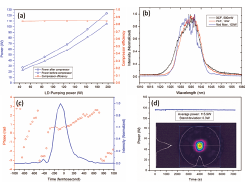Development of Sub-300 fs, 100-W Class, Yb-Fiber Based CPA Laser System at 1-MHz
Kobayashi Group
High repetition rate (>MHz) high harmonics generation (HHG) based vacuum ultraviolet (VUV) laser source is highly desirable for photoelectron spectroscopy, for space-charge-free measurement by limiting the number of emitted electrons per pulse, which can lead to higher signal-to-noise-ratios and achieve high energy resolution. Traditionally, Ti:sapphire laser systems were adopted as the driver, which, however, typically have a repetition rate on the order of a few kilohertz, or hundred kilohertz at the expense of the pulse energy. That is mainly limited by the poor thermal conductivity of the Ti:sapphire crystal itself. Even with the state-of-the-art cryogenic configuration, the average power is limited at a few tens of watts.

Fig. 1. (a), Power performance of the FCPA system; (b), Spectra taken from different stages of amplification; (c), Pulse intensity and phase obtained from the SHG-FROG measurement; (d), Power stability of the fiber CPA laser system and beam profile.
As far as high repetition rate, high average power lasers are concerned, Yb-based fiber, slab, and disk lasers are leading the trend in this field and all three have enabled >1 kW of average output power, due to their advanced heat dissipating ability. Comparatively speaking, slab lasers and disk lasers give pulse duration on the order of few picosecond or sub-picosecond. While, fiber lasers, due to the broader gain bandwidth they can support, can give shorter pulse duration. Unfavorably, due to the small core diameter of gain fibers, the peak powers reached inside the fiber are high and unwanted nonlinear effects, such as self-phase modulation, tend to occur. Hence, in order to avoid possible nonlinearities, the pulse duration of a seed laser needs to be stretched before it is amplified by a fiber amplifier. Although there have been some reports on high average power 1-MHz fiber chirped pulse amplification (FCPA) lasers, their pulse duration were limited to ~500 fs.
Here we report on a FCPA laser system, which delivered 100 W of output power after a pulse compressor, at a repetition rate of 1 MHz, corresponding to a pulse energy of 100 µJ. The compressor efficiency was as high as 85% thanks to the special large scale transmission gratings. The pulse duration was measured to be 270 fs using second harmonic generation frequency-resolved optical gating (SHG-FROG) method. To the best of our knowledge, this represents the shortest pulse duration achieved by a hundred-watt-level fiber chirped pulse amplification laser system at few MHz repetition rate, without resorting to any means of post-compression and SLM-based phase compensation. The excellent beam quality was guaranteed by the rod fiber itself and by careful alignment into this fiber to effectively excite the fundamental mode alone.
The FCPA system started from a mode-locked 64-MHz Yb:fiber oscillator with an average power of 5 mW. This seed laser was then directed to a grating based pulse stretcher, and stretched to be ~1 ns. A single mode Yb pre-amplifier followed the stretcher to boost the power up to ~100 mW. An acoustic optical modulator (AOM) was used to lower the repetition rate down to 1 MHz. Meanwhile, the average power was decreased to 0.5 mW. Additional two-stage pre-amplifiers increased the average power to 500 mW, which then seeded the following 40/200 photonic crystal fiber (PCF) amplifier that was pumped in the backward direction by a 25 W laser diode at 976nm. The final stage amplifier was a straight 55 cm rod fiber from NKT Photoncis, pumped by a fiber coupled 350-W laser diode centered at 976 nm. With a seed laser of 13W, more than 120 W average power was extracted when backward pumping at ~200 W was used, shown in Fig.1(a). The optical-to-optical efficiency was in excess of 60%. After compressor, more than 100 W of average power were obtained, corresponding to an efficiency of ~85% for the compressor. Fig.1(b) shows the spectrum taken after different amplifier stages. Only minor gain narrowing effects were visible. Figure 1(c) shows the measured pulse duration of ~270 fs. Figure 1(d) shows 2-hours operation of the system.
In the future, we would like to use this laser system to drive HHG process. By that, high repetition rate VUV laser could be expected soon.
References
- [1] Z. Zhao and Y. Kobayashi, Appl. Phys. Express. 9, 012701 (2016).
